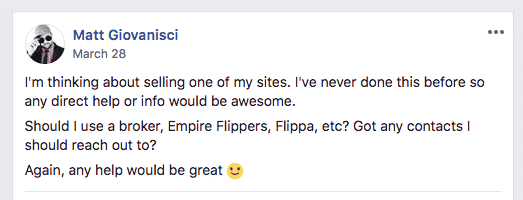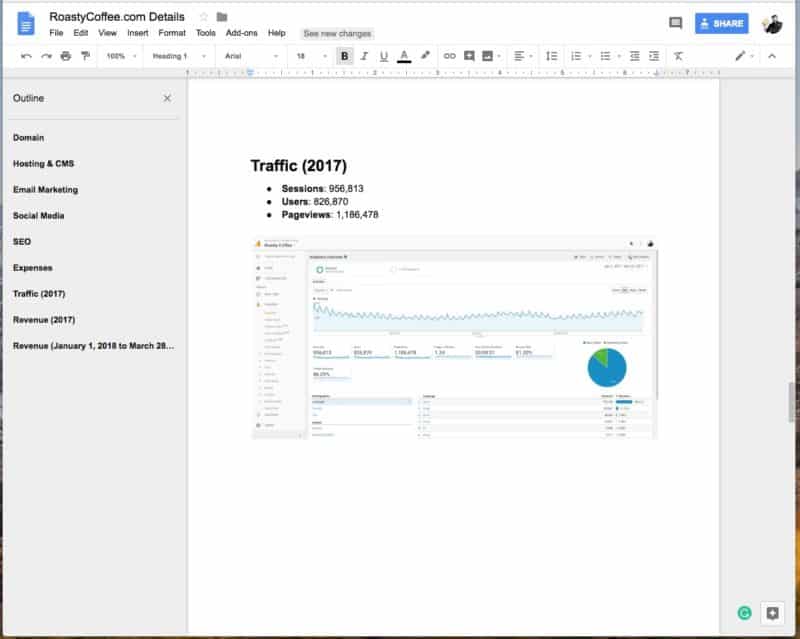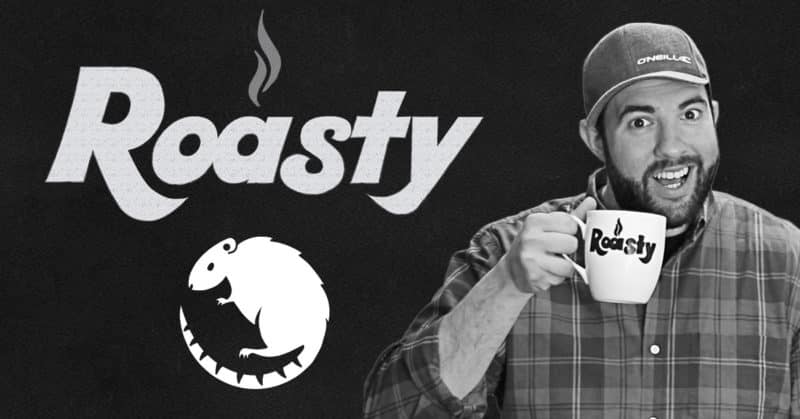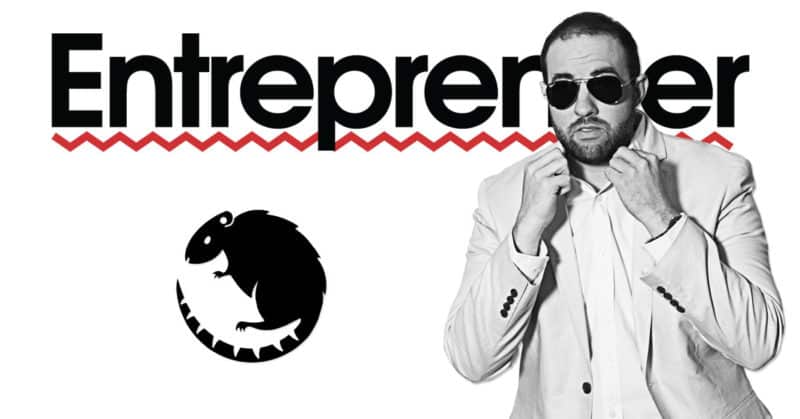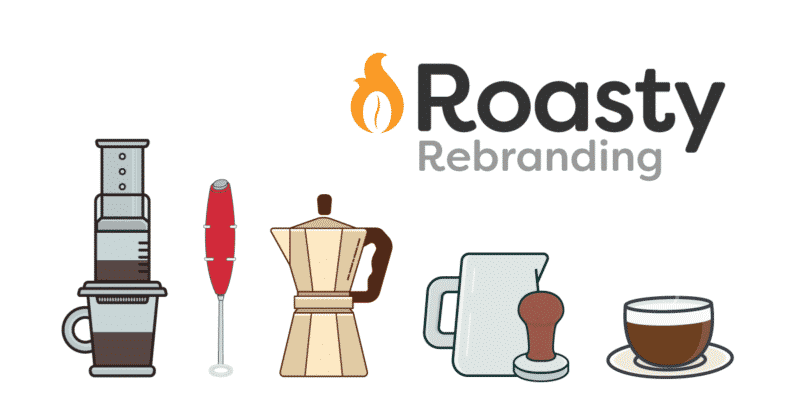In this post, I describe in full detail what I went through to sell my website for $55,000 after two years. But some names and identifying details have been changed to protect the privacy of individuals involved. I think that’s fair.
In March of 2018, I decided to sell my second largest website, Roasty Coffee.
It’s still a popular coffee site that gets decent traffic and subscribers. It also made me some healthy passive income of around $1,400 a month.
When I first launched Roasty in 2015, my goal was to prove to myself that I was good at building an audience. I did that [pats himself on back].
But I always struggled to figure out how Roasty would make more money. Enough that it could pay for itself plus a nice profit. Roasty had to be worth the effort of owning it.
But that wasn’t the case.
Roasty: A Site Fit For Someone Else
I started neglecting Roasty once Amazon fucked me. Even though my team was still working on it, I had personally checked out.
I recently got clear on my company’s mission statement. And I knew that Roasty needed a better monetization strategy. But we continued to double-down on content to boost traffic and increase affiliate commissions. That’s what my company did best.
After about a year, profits only increased by a small percentage. We weren’t seeing the income we saw before the Amazon affiliate debacle. At that point, I knew Roasty wasn’t working for us but would be a perfect fit for someone willing to sell their own physical coffee products.
Another thing I realized, sadly, is that I just wasn’t that into coffee anymore. Or maybe even to begin with. Don’t get me wrong, I fucking LOVE coffee, but I’m not obsessed with the process.
In early 2017, I started a new site called Brew Cabin all about homebrewing beer. This is something I’m completely obsessed with. I think about beer all day. I love making it, reading about it, and watching shitty videos of dudes talking about it like wine snobs.
Brew Cabin is new and only making about $150 a month. But my passion and interest carry the brand while it doesn’t make enough money to support itself.
All this, plus some financial priorities, led me to put Roasty on the backburner. And then I got the idea in my head that I would be okay with selling it.
My Reason For Selling
I wanted to quickly raise cash for a down payment on a future home. And since houses are outrageously overpriced where I live, I needed at least $150,000 to put 20% on a basic-ass house.
But things changed. Instead, I buried myself in credit card debt.
You see, Swim University (the site that pays my bills) is a seasonal business. And I did a lot of hiring last year during the really profitable months. But as the winter came, the profits dipped and the salaries increased. And I kept things afloat with a Chase Ink Preferred card.
Now, granted, this debt would likely be paid off once the summer came and we started raking in the big bucks. But it was a stressor for me. And I’m usually not one to fret about money.
However, I couldn’t help it. It was affecting me. The combo of a plateauing website and my financial woes led me to the decision to sell Roasty. After thinking about it for a month to make sure I was serious, I began to put the word out.
My Research on Selling a Website
I had a gut feeling Roasty was gonna be easy to sell. From my limited experience in trying to buy a website, I ran across a lot of crappy sites for sale. I knew Roasty was a diamond in a world of dogshit.
So I believed my site should be valued higher than every other site on the market simply because it looked better. I found out this idea was flawed.
I started researching how to evaluate a website and decided to build my own website valuation calculator that took into account the things that no one thinks about:
- Design
- Domain name branding/trademark
- SEO value
- Backlink Value
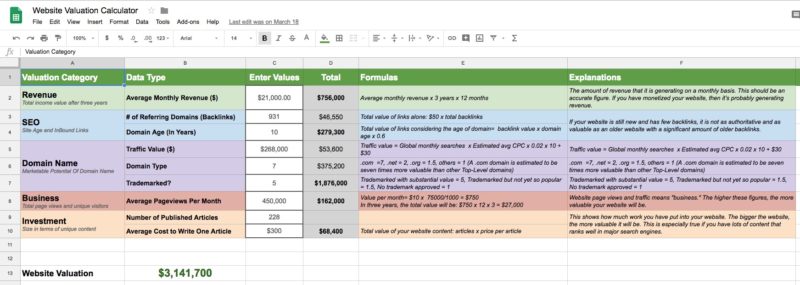
My flawed website valuation calculator
It turns out, a lot of site owners selling their site for the first time feel like they’re selling their baby and that it’s worth more.
It’s not. It’s worth what the market will pay for it.
The Initial Website Valuation
I ditched the calculator and decided to find out what the market was willing to pay. I started by writing a Facebook post in a group that I knew was filled with website buyers and sellers.
I also thought it would be a good idea to keep an updated Google Doc of information about Roasty. I started with the basics of things I knew they would ask for (after researching), like:
- Domain age
- Last 12 months of traffic
- Last 12 months of revenue
I was getting a lot of comments and people from the community started messaging me privately. As they asked me specific questions about the site, I updated the Google Doc so every potential buyer had access to new information.
I got a lot of help from the big website brokers that were in the community. They valued the site (roughly $50k – $60k) and gave me timelines on how fast they could sell it.
This seemed like a good avenue: hire a broker to find the buyer, manage the deal, and deliver the goods. In return, I’d pay a 15% commission fee of the final sale price.
But before I committed, I was getting a lot of interest from private buyers. So I wanted to see if I could save the 15% and broker the deal myself.
I came up with my “magic number” which I knew was high. I was asking $75,000. I mean, Roasty was my baby 🍼
Tapping Into The Social Pipeline
While I was building the Google Doc and responding to buyers, I continued to reach out to other Facebook communities and people I knew personally.
I started asking my friends, “have you ever sold a website before?” A few had, and I jumped on the phone to get their advice. Some friends introduced me to other people who had sold websites and I got their insight too.
I even reached out to my lawyer and accountant to make sure there was nothing I was missing. For instance, what taxes would I pay? Would I have to sign a non-compete? Was it even worth it or possible to sell? You know, minor things like that 🙂
After about a week of getting feedback and insight, I had a pretty firm grasp on my two choices:
- Take my time, sell it privately, and make more money.
- Hand it over to a broker, sell it quickly, and make less money.
How About The Best of Both Worlds?
I want to point out how much help I got in this process. Sure, a lot of the help came from brokers who stood to make money off the deal. But to be fair, a lot of the real help came from friends and friends of friends.
In fact, the biggest help came from a friend of a friend who was also a broker and didn’t have any skin in the game. They told me…
You have a great site but it’s not very big. You could sell it with a broker and save yourself the stress, but you’ll make less money. Or you could sell it privately and that’s what I recommend you do. You’ll make more money, you’ll learn, and you seem competent enough to do the technical transition stuff. Also, if you need an agreement, you can use ours – just make sure you have a lawyer.
That’s what I decided to do. I was in no rush to the sell the website. It was making passive income. I could take my time and find a buyer who would take care of the site and do it justice.
And luckily, it took only a few days before I found that buyer.
Two Buyers, One Deal
One buyer came out of nowhere. They didn’t even know I was actively selling. They reached out on my Brew Cabin Instagram account after finding out I also owned Roasty. So by total coincidence, they asked if I was interested in selling.
Holy shit, that was weird.
Even weirder was the fact that they lived in the next town over. But that didn’t have anything to do with the offer, it was just weird.
We went back and forth trying to come to an agreement. Their initial offer was below my asking price and the initial valuation I got from the brokers.
Instead, they proposed two different partnership deals, which I declined. I wanted a clean break. And if I learned anything about myself in the last two years, I don’t perform well in partnerships.
So that deal didn’t work out.
At the same time, I had a Skype call with someone I was introduced to through a private Facebook group. While they weren’t interested in buying the site, they knew someone who might.
So I had a call with the interested buyer and it went really well. They just asked some questions about the site, which I was able to answer on the spot. We talked about our own current businesses too and just really hit it off.
I mentioned my magic number was $75,000. I knew it was high, but it was what I thought the site was worth.
They got back me a few days later and said that they couldn’t afford my asking price. But I had a good feeling about this buyer. So instead of walking away, I responded, “make me an offer anyway.”
After doing their own valuation, here’s what they offered in the email:
I’d be able to do the high end of a brokerage value – 36 times the monthly net: $51,498. You’d also save 15% in commissions.
I’m not a skilled negotiator, but I asked to make it a cool $55k and we had a deal.
Contracts, Escrow, and Delivery
It was the beginning of May and we had a long road ahead before the deal was closed. They needed to secure a loan and I needed to draw up the agreement.
Thankfully, that broker (who recommended I sell privately) gave me their boilerplate agreement. I ran through it once and added in all the details about the sale and the assets I’d be handing over.
Then, I sent it off to my lawyer to edit via a shared Google Doc. (In case you haven’t noticed, I fucking love Google Drive. Thinking about making a course on how I use it).
Once the loan was secured and the agreement was signed, I set up a transaction in my Escrow.com account. The money was wired and held in escrow and it was time to start transferring the assets starting with the WordPress site and domain name.
Delivering The Goods
I created a project in Asana that broke down every task needed to fully deliver Roasty to the buyer. I deleted the project, so I don’t have a screenshot. I’ll do my best to remember the tasks in order:
- Allow access to buyer’s hosting company (WPX) into my
web hosting account (WPEngine) to do a site copy/transfer. - Point the domain nameservers (on GoDaddy) to the new hosting account where a copy of Roasty lived.
- Initiate a domain name account transfer. (godaddy to Namecheap).
- Wait for Buyer to set up a branded email account.
- Send password to Gumroad account for the Roasty Video Course
- Send passwords to Twitter and Pinterest.
- Transfer ownership of Facebook and YouTube accounts.
- Transfer ownership of Google Analytics account.
- Send a copy (via Google Drive) of all Roasty marketing assets including original course videos, logos, and graphic elements.
Once the buyer approved everything, it was successfully transferred, they released the payment, and I got the money in 48 hours.
Tying Up The Loose Ends
To be honest, the entire process was easy. I wasn’t stressed at all. So not like me.
I knew what I was doing on the tech side of things. And the buyer was really cool throughout the entire ordeal. This is the main reason I wanted to sell the site to them – I had a good feeling.
That said, I want to make sure they were happy with everything. There were some things we needed to address after the transaction.
For instance, Roasty uses my WordPress plugin for managing affiliate links. So the both of us had to go through every link and make sure they were updated to the new link tag.
I’ve been checking every day to make sure we didn’t miss anything. This will probably last a few more days.
For the most part, the deal is done. I promised the buyer I would keep an eye on things and be available to answer any questions until the end of June 2018. I’m sure by that point, they won’t need to contact me, if not sooner.
Did I Actually Make Money?
I was able to pay off my business debt (around $37,000) and give myself a bonus (exactly $10,000). I worked with my accountant to make sure I recorded the transactions appropriately in Quickbooks.
This is capital gains income and not business revenue. So things had to be treated differently in the accounting software.
I’m using part my bonus to pay off my small personal credit card debt. The rest will be added to a savings account for buying a house.
I didn’t make enough to cover the down payment in one shot, but every little bit helps.
I really wanted to know if, after two years of owning Roasty, if I actually made any money. Or maybe I broke even or lost money. So I gathered the information I had over the lifetime of owning roasty and did the math.
The Lifetime Stats
- Months in Action: 37 (March 2015 to April 2018)
- Total Unique Visitors: 1,905,013
- Active Email Subscribers: 8,218
The Lifetime Expenses
- Writing and Graphic Design: $16,469.00
- Editing: $6250.00
- Domain Names: $152.69
- Hosting: $1,073.00
- MailChimp: $1,095.00
- Total: $25,039.69
The Lifetime Revenue
- Amazon Associates: $48,992.53
- Sponsorships: $1,550.00
- Course Sales: $825.00
- Total: $51,367.53
The Money I Made
Wow! That took a long time to compile. Writers came and went, and MailChimp and hosting have other accounts to consider.
- The site profited: $26,327.84
- The site sold for: $54,755.25 (after Escrow.com expenses)
- Total: $81,083.09
Of course, that doesn’t include my own personal time, but that’s not a bad earning for two years of work. That’s an annual salary of roughly $40,541.55.
Taking into consideration that I started the site from the ground up. It was a brand new domain with new content and no existing industry leverage.
To be honest, I’m pretty fucking blown away by this right now. This is the first time I’m doing this kind of math. It’s amazing to think that in two years, I could have replaced my income if I were working a normal job.
Like I’d ever get a normal job. Fuck that!
All in all, I’m happy I sold the site to someone I know will take care of it. And, more importantly, I’m happy I made all that sweet, sweet coin.
